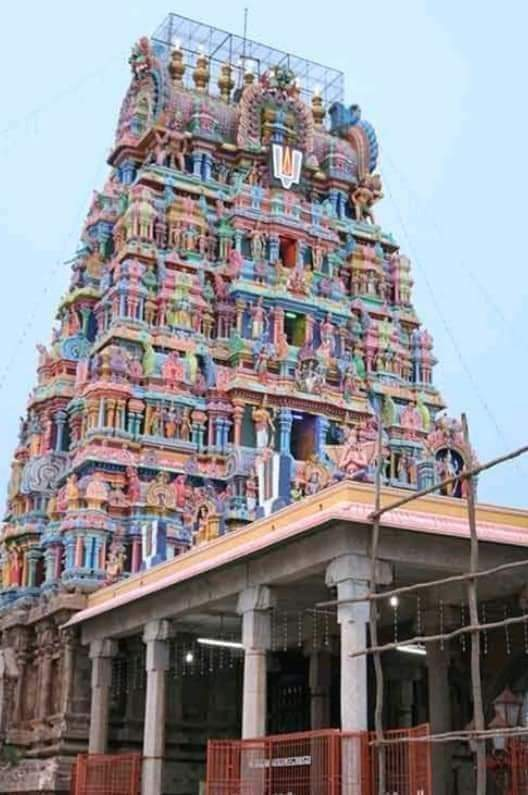#திருமுருக_கிருபானந்த_வாரியார் பாமரனின் உள்ளத்தில் பரமனை விதைத்த இவருக்கு எத்தனை நமஸ்காரங்கள் செய்தாலும் போதாது. வேலூர் மாவட்டம், காட்பாடிக்கு அருகில் பாலாற்றங்கரையில் அமைந்த காங்கேயநல்லூரில் செங்குந்த வீர சைவ மரபில் வந்த மல்லையதாசர் - கனகவல்லி தம்பதியரின் 11 குழந்தைகளில் 4வது 

குழந்தையாக 1906 ஆம் ஆண்டு ஆகஸ்ட் 25 ஆம் தேதி பிறந்தவர் ஸ்ரீ கிருபானந்த வாரியார். இசையாலும், புராணச் சொற்பொழிவாலும் இறைவன் புகழ்பாடி வந்த மல்லையதாசர் முருகப்பெருமானின் பல நாமங்களில் ஒன்றான "கிருபானந்த வாரி" எனும் பெயரை இவருக்குச் சூட்டினார். வாரியாருக்கு அறிவு ஞானம் அனைத்தையும்
வழங்கியதும் இவரே. வீட்டிலேயே இலக்கியம், இலக்கணம், இசை எல்லாம் கற்றுக் கொடுத்தார். பிரம்மஸ்ரீ தென்மடம் வரதாச்சாரியாரிடம் 4 வருடங்கள் வீணை கற்றார் வாரியார். 8 வயதில் வெண்பா பாடும் ஆற்றல் வந்தது. 12 வயதில் 10,000 பாடல்களை மனப்பாடம் செய்தார். 5வது வயதில் திருவண்ணாமலையில், பாணிபாத்திர 

தேவர் மடத்தில் சிவலிங்க தாரணம் செய்விக்கப் பெற்றார் (கழுத்தில் சிவலிங்கம் அணிந்தார்). வாரியார் சுவாமிகள் அமிர்தலட்சுமியைத் தனது 19ஆவது வயதில் திருமணம் புரிந்தார். தினமும் முருகனுக்கு பூஜை செய்த பின்பே உணவு உட்கொள்வது வழக்கம். தொடர்ந்து 57 வருடங்கள் ஒரு நாள்கூட இடைவெளி இன்றி பூஜை 

செய்தவர். தனது சங்கீத ஞானத்தால் அவர் கதாகாலட்சேபம் செய்யும் பொழுது திருப்புகழ், தேவாரம், திருவாசகம் முதலான தோத்திரப் பாக்களை இன்னிசையுடன் பாடுவார். தன் தந்தையின் வழியில் வாரியார் சுவாமிகள் தமது 15-ஆம் வயதிலிருந்தே சொற்பொழிவு செய்யும் திறம் பெற்றார். 19-ஆம் வயதிலிருந்தே தனியாகப்
புராணப் பிரசங்கங்கள் செய்ய ஆரம்பித்தார். அவருடைய பிரசங்கங்கள் பெரும்பாலும் பேச்சு வழக்கை ஒட்டியே அமைந்திருந்த காரணத்தால், பாமர மக்களது உள்ளம் கவர்ந்தவரானார். பாமரர்களுக்கும் புரியும் விதமாக வேதாந்த உண்மைகளையும் சிந்தாந்தக் கருத்துகளையும் கூறினார். சுவாமிகள் சைவ சித்தாந்தத்திலும்
பெரும்புலமை பெற்றவர். திருப்புகழ் உரை நடை, மகாபாரதம், கம்பராமாயணம், கந்த புராணம், பெரிய புராணம் என்று இவர் எழுதிய நூல்களின் எண்ணிக்கை 200 இருக்கும். எம்பெருமான் திருவருளாலே #வயலூர்_எம்பெருமான் என்ற வார்த்தைகள் இல்லாமல் அவர் பேசியதே இல்லை! அவருடைய சொற்பொழிவுகளுக்கு இடையிடையே
குட்டிக் கதைகள் வரும். நகைச்சுவையும் நடைமுறைச் செய்திகளையும் நயம்படச் சொல்வதும் இவருக்குரிய சிறப்பு இயல்பு. வாரியார் ஒரு சமயம் ஒரு ஊரில் சொற்பொழிவாற்றிக் கொண்டிருந்தார். அவர் மிகுந்த சுவாரசியமாகப் பேசிக் கொண்டிருந்த போது பாதியில் ஒவ்வொருவராக எழுந்து போய்க் கொண்டிருந்தனர். அவர்களை
பார்த்து வாரியார், "ராமாயணத்தில் அனுமனை 'சொல்லின்செல்வர்' என்று குறிப்பிடுவார்கள். இந்த ஊரிலும் சொல்லின் செல்வர்கள் பலர் இருப்பதைப் பார்க்கிறேன்" என்றார். போய்க் கொண்டிருந்தவர்கள் யாரைச் சொல்லப் போகிறார் என்று தெரிந்து கொள்ள ஆவலுடன் நின்றனர். வாரியார் தொடர்ந்து, "நான் நல்ல பல
விஷயங்களைச் சொல்லின் அதைக் கேட்காமல் செல்பவரைத் தான் சொல்கிறேன்" என்றார். எழுந்து சென்றவர்கள் மீண்டும் அவர்கள் இடத்திற்கு வந்தமர்ந்தனர். வாரியார் சொற்பொழிவில் கூட்டத்திற்குக் குறைவு இருக்காது. இந்தக் கூட்டத்தில் பெண்கள் எண்ணிக்கைக்கும் குறைவு இருக்காது. பெண்களைக் குறைவாகப்
பேசுவது அவருக்குப் பிடிக்காது. பெண்களை அடிமையாக நினைக்கும் ஆண்களை எச்சரிக்கும் விதமாக "மனைவியைக் கோபிக்கும் ஆண்கள் இருக்கக் கூடாது. மனைவி கண்ணீர் சிந்தினால் அந்தக் குடும்பம் தளைக்காது" என்று சொல்வதுண்டு. குழந்தைகளுக்குப் பெற்றெடுத்த தாயின் பெயரை முதலெழுத்தாக (இனிஷயலாக) போட்
வேண்டும் என்று பெண்களை முன்னிறுத்தும் கருத்தை முதன் முதலாகச் சொல்லியவரும் வாரியார்தான். 20 வயதுக்கு மேல், மேல் சட்டை அணிந்தது இல்லை. ஆட்டோகிராஃப் கேட்பவர்களுக்கு இரை தேடுவதோடு இறையையும் தேடு என்ற வார்த்தைகளையே எழுதிக் கையெழுத்து இடுவார்! 20-ஆம் நூற்றாண்டின் 2வது அருணகிரிநாதராக
விளங்கிய #பாம்பன்_சுவாமிகள் சண்முகநாதனை மும்முறை நேரில் தரிசித்துள்ளார். ஏராளமான கோவில்களுக்கு திருப்பணி செய்து கொடுத்த பெருமையும் இவருக்கு உண்டு. ஒரு முறை பழநி ஈசான சிவாச்சாரியார் என்பவர் லியோ டால்ஸ்டாய் எழுதிய "நாம் என்ன செய்யவேண்டும்?" என்ற நூலை வாரியாரிடம் தந்தார். அந்த நூலைப
படித்த வாரியாருக்கு பொன், பொருள் உலகம் என்ற பற்று பறந்து போயிற்று. தான் அணிந்திருந்த தங்க நகைகளை காங்கேய நல்லூர் முருகனுக்குக் காணிக்கை ஆக்கினார். திருச்சியிலிருந்து கரூர் செல்லும் வழியில் திருப்பராய்த்துறை எனுமிடத்தில் பிரம்மச்சாரி ராமசாமி என்பவர் தொடங்கிய இராமகிருஷ்ண குடில்
எனும் அமைப்புக்கு இவர் பல ஆண்டுகள் நன்கொடை வசூல் செய்து கொடுத்து வந்தார். அனாதைக் குழந்தைகளுக்கு அடைக்கலம் அளித்து வரும் இந்த அமைப்பு இன்று வளர்ந்திருப்பதற்குக் காரணம் வாரியார் சுவாமிகள்தான். ஏழை எளிய குடும்பத்து மாணவர்களின் கல்விச் செலவுக்காக இவர் பல நன்கொடைகளைக் கொடுத்துள்ளார்.
இவர் பிறந்த காங்கேயநல்லூரில் பல கல்வி நிறுவனங்களைத் தொடங்கியிருக்கிறார். இன்றும் இவருடைய பெயரால் மேல்நிலைப் பள்ளிகள் பெண்களுக்கும், ஆண்களுக்கும் தனித்தனியாக நிறுவியிருப்பதைக் காணலாம்.சு வாமிகள் 1936 ஆம் ஆண்டு தைப்பூச விழாவுக்கு வடலூர் சென்றிருந்த சமயம், சத்திய ஞான சபையில் அமர்ந்த
#திருப்புகழ்_அமிர்தம் என்ற மாதப் பத்திரிகையை வெளியிடக் கருதி #கைத்தலநிறைகனி என்று தொடங்கும் திருப்புகழுக்கு உரை எழுதினார். அது முதல் திருப்புகழ் அமிர்தம் திங்கள் இதழாகப் பிரசுரமாகத் தொடங்கியது. சுவாமிகள் அந்தப் பத்திரிகையை 37 ஆண்டுகள் தொடர்ந்து நடத்தினார். அந்தப் பத்திரிகையில் 

ஒவ்வொரு மாதமும் ஒவ்வொரு திருப்புகழ் பாடலுக்கு விளக்கவுரையும், கந்தர் அலங்கார உரையும், கற்பு நெறிக்கதையும், வேறு பல கட்டுரைகளும் எழுதினார். அந்தப் பத்திரிகையில் வெளிவந்த கட்டுரைகள் பின்னர்த் தொகுக்கப்பட்டு தனித்தனி நூல்களாகப் பிரசுரமாயின. பாமர கொள்ளும்படி 500க்கும் மேற்பட்ட ஆன்மிக
கட்டுரைகள் எழுதியுள்ளார். வாரியார் தம்பதிகளுக்கு குழந்தைகள் ஏதுமில்லை என்றாலும் குழந்தைகள் மீது அளவற்ற அன்பு கொண்டிருந்தார். தன் கூட்டங்களில் குழந்தைகளுக்கு முன் வரிசையில் இடமளித்த இவர், குழந்தைகளுக்காக "தாத்தா சொன்ன குட்டிக்கதைகள்' என்ற நூலை அவர் படைத்தார். இதில் குழந்தைகளுக்குத
தேவையான நல்ல கருத்துக்களையும், எதிர்காலத்திற்கேற்ற சிந்தனைகளையும் அளித்திருந்தார். அவர் இயற்றியுள்ள நூல்கள் ஏறத்தாழ நூற்றைம்பது ஆகும். அவற்றுள் சிவனருட்செல்வர், கந்தவேள் கருணை, இராமகாவியம், மகாபாரதம் ஆகியவை சிறப்பாகக் குறிப்பிடத்தக்கவை. பாம்பன் சுவாமிகளின் வாழ்க்கை வரலாற்றையும்
எழுதியுள்ளார். கேட்கும் செவிக்கும் கற்கும் சிந்தைக்கும் இன்பம் பயக்கும் அவரது சொற்பொழிவுகளுள் 83 சொற்பொழிவுகள் குறுந்தகடுகளாக வந்துள்ளன. "இறைவனை ஏன் வணங்க வேண்டும்? இறைவனை வணங்காவிடில் கடவுளுக்கு என்ன நஷ்டம்? மனித வாழ்வில் இறையுணர்ச்சி இல்லாமல் வாழ முடியாதா? என்ற கேள்விகளை
நாத்திகப் பெருமக்கள் கேட்கிறார்கள். விலங்குகளும் உண்கின்றன. உறங்குகின்றன; உலாவுகின்றன; இனம் பெருக்குகின்றன; மனிதர்களாகிய நாமும் உண்கிறோம். உறங்குகிறோம். உலாவுகிறோம்; இனம் பெருக்குகிறோம். இவை விலங்குகட்கும், மனிதர்கட்கும் ஒன்றாகவே அமைந்திருக்கின்றன. விலங்குகளினின்றும் மனிதன்
உயர்ந்து விளங்குவது தெய்வ உணர்ச்சி ஒன்றினாலேயாகும்" என்று இறைவழிபாட்டிற்கான காரணத்தைச் சொன்னார் வாரியார். உள்நாட்டில் மட்டுமின்றி, அமெரிக்கா, இலங்கை, சிங்கப்பூர், மலேசியா, லண்டன், சுவிட்சர்லாந்து என பல நாடுகளில் சொற்பொழிவுகளை நிகழ்த்தி இருக்கிறார். இதற்காகப் பல பட்டங்களையும்,
விருதுகளையும் பெற்றிருக்கிறார். கலைமாமணி, திருப்புகழ்ஜோதி, பிரவசன சாம்ராட், இசைப்பேரரசர், அருள்மொழி அரசு போன்றவைகளைக் குறிப்பிடலாம். வாரியார் சுவாமிகள் 1993 ஆம் ஆண்டில் அக்டோபர் மாதம் லண்டன் நகருக்குச் சொற்பொழிவாற்றச் சென்றார். அங்கு திடீரென ஏற்பட்ட உடல்நலக் குறைவால் சிகிச்சை
பெற்றுக் கொண்டு நவம்பர் மாதம் 6 ஆம் தேதி லண்டனிலிருந்து திரும்பினார். 7 ஆம் தேதி அதிகாலை மும்பை வந்து சேர்ந்தார். அங்கிருந்து காலை 6 மணிக்கு சென்னைக்கு விமானத்தில் கிளம்பினார். சென்னை வருவதற்கு முன்பாகவே வானிலேயேஅவர் உயிர் இறைவனிடம் சென்று சேர்ந்து விட்டிருந்தது. முருகன் அவன்
வாகனமான மயிலை அனுப்பி அவரை ஏற்றுக் கொண்டிருக்கிறான் போலும்! கிருபானந்த வாரியாரின் சொந்த ஊரான காங்கேயநல்லூருக்கு அவரது உடல் எடுத்துச் செல்லப்பட்டது. அங்கே முருகன் கோவில் எதிரே #சரவணபொய்கை_குளம் என்ற மண்டபம் ஒன்றை கிருபானந்த வாரியார் ஏற்கனவே உருவாக்கி இருந்தார். அந்த மண்டபத்தில் 

உயரமான மேடை அமைத்து அதில் உட்கார்ந்த நிலையில் வாரியார் உடல் வைக்கப்பட்டது. தற்போது இது "திருமுருக கிருபானந்த வாரியார் திருக்கோயில்" ஆகியிருக்கிறது. காங்கேயநல்லூரில் அவர் வாழ்ந்த வீடு இன்று நினைவில்லமாக ஆக்கப்பட்டுள்ளது. இந்திய அரசு இவருடைய உருவம் பொறித்த தபால் தலையை 2006ஆம் 

ஆண்டு வெளியிட்டு சிறப்பித்திருக்கிறது. சிங்கபுரி நடராஐர் சன்னதி பிரகாரத்தில் வடகிழக்கே திருமுருக கிருபானந்த வாரியார் சுவாமி திருமேனி நிறுவப்பட்டுள்ளது. #அறிவோம்_மகான்கள்
சர்வம் ஸ்ரீ கிருஷ்ணார்ப்பணம்🙏🏾
சர்வம் ஸ்ரீ கிருஷ்ணார்ப்பணம்🙏🏾

தமிழ் எழுத்துகளில் ஐ என்ற எழுத்தை திராவிட கட்சிகளிடம் இருந்து காப்பாற்றி தமிழ் எழுத்துகளில் ஒன்றாக வைத்து காப்பாற்றியவர் வாரியார் சுவாமிகள். இவர் 64 வது நாயன்மாராக போற்றப்பதுவதில் ஆச்சரியம் இல்லை. 

@threadreaderapp unroll
• • •
Missing some Tweet in this thread? You can try to
force a refresh




















